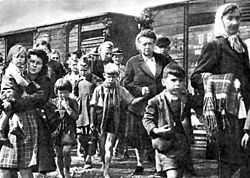Operation Black Tulip
 |
| Flight and expulsion of Germans during and after World War II |
|---|
| (demographic estimates) |
| Background |
| Wartime flight and evacuation |
| Post-war flight and expulsion |
| Later emigration |
Operation Black Tulip was a plan in 1945 by Dutch minister of Justice Kolfschoten to evict all Germans from the Netherlands. The operation lasted from 1946 to 1948 and in the end 3,691 Germans (15% of German residents in the Netherlands) were deported.
Background
After World War II, the Netherlands was a country in ruins and the major pre-war trade lines with Germany and Indonesia were severed. Because of the importance of trade with Germany, the proposed demand for compensation (25 billion Guilders—a tenfold of the actual damage) was dropped. But there was still a lot of resentment. Many people were arrested, most notably collaborators (NSB). The 25,000 people living in the Netherlands with German nationality (who often had Dutch wives and children) were branded as 'hostile subjects' (vijandelijke onderdanen). They were to be evicted in three groups in reverse order of entry. The first who had to leave were those who came after the start of the war (mostly factory workers), then those who came after 1932 (including political refugees, some of them Jews), and then the rest: many of whom were economic refugees from the 1920s.
Timeline
The operation started on 11 September 1946 in Amsterdam, where Germans and their families were taken from their homes in the middle of the night and given one hour to collect fifty kilograms of luggage. They were allowed to take one hundred Guilders. The rest of their possessions went to the state. They were taken to internment camps near the German border, the biggest of which was Mariënbosch near Nijmegen.[1]
The allied forces that occupied Western Germany didn't like this operation because other countries might follow suit and western Germany was in too bad a state to receive all these newcomers. The British troops in Germany reacted by evicting 100,000 Dutch citizens in Germany to the Netherlands.[1]
The operation ended in 1948, and on 26 July 1951, the state of war with Germany officially ended, the Germans no longer being regarded as state enemies.
Documentary
An episode of the Dutch TV show Andere Tijden was devoted to these events.
See also
- Bakker-Schut Plan
- Flight and expulsion of Germans during and after World War II
Notes
Literature
- Bogaarts, Melchior D. (1995), "Weg met de moffen", Parlementaire geschiedenis van Nederland na 1945 (in Dutch) D (2 ed.), Nijmegen, ISBN 90-71478-37-8.
- Bogaarts, M. D. (1981), "'Weg met de Moffen' – De uitwijzing van Duitse ongewenste vreemdelingen uit Nederland na 1945", Bijdragen en Mededelingen betreffende de Geschiedenis der Nederlanden (The Low Countries Historical Review) (in Dutch) (Koninklijk Nederlands Historisch Genootschap (Royal Netherlands Historical Society)) 96 (2): 334–351
External links
- (Dutch) Website Operatie Black Tulip]
- (Dutch) the documentary Black Tulip.